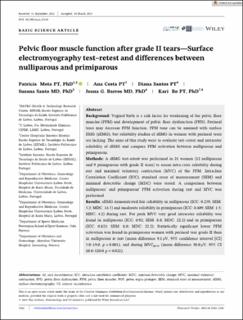| dc.contributor.author | Mota, Patrícia | |
| dc.contributor.author | Costa, Ana | |
| dc.contributor.author | Santos, Diana | |
| dc.contributor.author | Santo, Susana | |
| dc.contributor.author | Barros, Joana G. | |
| dc.contributor.author | Bø, Kari | |
| dc.date.accessioned | 2023-10-16T13:04:53Z | |
| dc.date.available | 2023-10-16T13:04:53Z | |
| dc.date.created | 2023-04-27T13:39:26Z | |
| dc.date.issued | 2023 | |
| dc.identifier.citation | Neurourology and Urodynamics. 2023, 42(5), Side 1162-1168. | en_US |
| dc.identifier.issn | 0733-2467 | |
| dc.identifier.uri | https://hdl.handle.net/11250/3096771 | |
| dc.description | This is an open access article under the terms of the Creative Commons Attribution‐NonCommercial License, which permits use, distribution and reproduction in any medium, provided the original work is properly cited and is not used for commercial purposes. | en_US |
| dc.description.abstract | Background: Vaginal birth is a risk factor for weakening of the pelvic floor muscles (PFM) and development of pelvic floor dysfunction (PFD). Perineal tears may decrease PFM function. PFM tone can be assessed with surface EMG (sEMG), but reliability studies of sEMG in women with perineal tears are lacking. The aims of this study were to evaluate test–retest and intrarater reliability of sEMG and compare PFM activation between nulliparous and primiparous.
Methods: A sEMG test–retest was performed in 21 women (12 nulliparous and 9 primiparous with grade II tears) to assess intra-rater reliability during rest and maximal voluntary contraction (MVC) of the PFM. Intraclass Correlation Coefficient (ICC), standard error of measurement (SEM) and minimal detectable change (MDC) were tested. A comparison between nulliparous' and primiparous' PFM activation during rest and MVC was performed.
Results: sEMG demonstrated fair reliability in nulliparous (ICC: 0.239; SEM: 5.2; MDC: 14.5) and moderate reliability in primiparous (ICC: 0.409; SEM: 1.5; MDC: 4.2) during rest. For peak MVC very good intrarater reliability was found in nulliparous (ICC: 0.92; SEM: 8.0; MDC: 22.2) and in primiparous (ICC: 0.823; SEM: 8.0; MDC: 22.2). Statistically significant lower PFM activation was found in primiparous women with perineal tear grade II than in nulliparous at rest (mean difference 9.1 µV, 95% confidence interval [CI] 3.0–19.0, p = 0.001), and during MVCpeak (mean difference 50.0 µV, 95% CI 10.0–120.0 p = 0.021).
Conclusions: sEMG is reliable when measuring PFM activation in primiparous women with perineal tears grade II. Women with perineal tears grade II have lower PFM activation both during rest and MVC. | en_US |
| dc.language.iso | eng | en_US |
| dc.subject | grade II perineal tears | en_US |
| dc.subject | pelvic floor muscles | en_US |
| dc.subject | reliability | en_US |
| dc.subject | surface electromyography | en_US |
| dc.title | Pelvic floor muscle function after grade II tears: Surface electromyography test: Retest and differences between nulliparous and primiparous | en_US |
| dc.type | Peer reviewed | en_US |
| dc.type | Journal article | en_US |
| dc.description.version | publishedVersion | en_US |
| dc.rights.holder | © 2023 The Authors | en_US |
| dc.source.pagenumber | 1162-1168 | en_US |
| dc.source.volume | 42 | en_US |
| dc.source.journal | Neurourology and Urodynamics | en_US |
| dc.source.issue | 5 | en_US |
| dc.identifier.doi | 10.1002/nau.25180 | |
| dc.identifier.cristin | 2143834 | |
| dc.description.localcode | Institutt for idrettsmedisinske fag / Department of Sports Medicine | en_US |
| cristin.ispublished | true | |
| cristin.fulltext | original | |
| cristin.qualitycode | 1 | |
